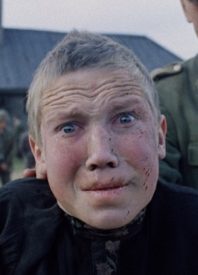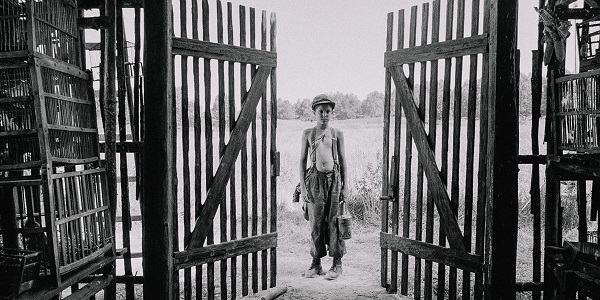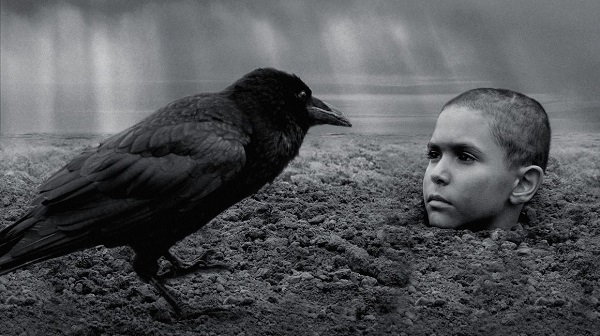
As World War II retreats farther and farther into the history books, it can be easy to forget the true abject horror that ran rampant between 1939 and 1945. While there is certainly no shortage of cinematic representations of that grave moment in time, the bland ubiquity of them sometimes only serves to soften and mythologize the facts, ultimately turning wartime milieu into an exciting fantasy land no different than Narnia or Middle Earth. It’s telling that the biggest audience crowd pleaser of last year was Jojo Rabbit, a film that uses the Holocaust as a coming-of-age trope in the Wes Anderson-like story of a cute young Nazi-in-training getting over his ingrained prejudices to save the Jewish girl that he has a crush on – ahhh, innocent boyhood adventures, amirite? Never mind the reality that neo-Nazis wield more political and social influence these days than ever before.
But seeing the war through the eyes of a child can still be an effective technique, with that relatively innocent perspective painting a more honest psychological portrait. Two films currently in the spotlight, Elem Klimov’s essential Come and See and Václav Marhoul’s The Painted Bird, do exactly that, creating heightened POV fever dreams that depict life during wartime at its most garishly terrifying. Neither of them are necessarily true stories but they feel more thematically real than any conventional WW2 dramatization.
Come and See went through its own kind of hell to even get to the screen, debuting in 1985 after years of pushback from Soviet censors over the searing nature of the screenplay. Immediately, it was considered a masterpiece, becoming a staple of international anti-war cinema and serving as Klimov’s final word in the medium, with the lauded director never making another film until his death in 2003. For two and a half hypnotically grueling hours, we are locked into the seemingly real-time perspective of young teenager Flyora, who signs up for the Soviet resistance once Nazi forces start to invade the Belorussian countryside where he resides. Filled with youthful enthusiasm at first, Flyora is plunged into a nightmare-scape of shattering air strikes, ruthless Nazi takeovers and disquieting piles of dead bodies of family, friends and countrymen.
Despite its monumental status, Come and See has only been available on a washed out, inferior-looking DVD for the last couple of decades, making its recent arrival to the Criterion Collection a bona fide cinematic event. Using a new 2K restoration from Mosfilm, Klimov’s crushing audiovisual experience is completely enveloping from first frame to last and you can see its influence on subsequent you-are-there Holocaust films, such as László Nemes’s similarly devastating Academy Award winner Son of Saul. In the lead role, Aleksey Kravchenko (who, in initial considerations, was due to be hypnotized during film making to avoid any chance of PTSD) fixes a look of wide-eyed horror to his face, trudging through mud, grime and blood to witness an unending procession of atrocities. By the end, he is as wrinkled and exhausted as a much older man (an image conveyed beautifully on the new Criterion artwork), living through what seems like an entire lifetime in the span of just a few days.
As shattering as Come and See remains, The Painted Bird, now hitting VOD platforms, takes things to another level of existential bleakness. Right from its debut at Venice and Toronto last year, audience reaction was wildly divided, with walk-outs of the nearly three-hour opus becoming a regular occurrence due to its explicit portrayal of sexual violence and other assorted deviancies. Taking an even more allegorical approach, Václav Marhoul’s adaptation of infamous Polish author Jerzy Kosiński’s novel follows a young Jewish boy named Joska in an unnamed region of Eastern Europe, who wanders the barren countryside after the aunt who he’s been sent to live with suddenly dies. From here, he encounters an array of mostly threatening characters, evoking the vibe of a twisted fairy tale as he attempts to journey home to his parents with war raging all around him.
Kosiński’s source material already came with its own controversial legacy, of course. Heralded as one of the greatest books to reflect on the Holocaust upon its release in 1965, The Painted Bird was purportedly an autobiographical account of Kosiński’s own childhood experiences, until it was exposed as pure fiction once the true details of his relatively safe upbringing became known. But even though it was as big a literary scandal as when James Frey was shamed by Oprah on her show years later for making up A Million Little Pieces, the question of authorial intent does little to dull the impact of the actual story, rendered exquisitely on screen in a stark black-and-white shooting style by Marhoul, a relatively unknown director outside of his native Czech Republic.
A surreal kaleidoscope of despair, The Painted Bird breaks the narrative down into chapters, each one marking a new way station for our young hero, where, in attempting to find shelter and guidance, he continually falls prey to the whims of adults left to their own psychotic devices. And what makes Joska’s journey even scarier is that he has as much to fear from the simple village-folk scattered around his environment as he does from invading Nazi soldiers, experiencing firsthand all kinds of sexual abuse and unbridled degradation from seemingly regular people taking a page out of the Third Reich’s torture playbook.
At such a long length, the film does sometimes struggle under the weight of its own pretensions and the sudden appearance of famous faces at various intervals (such as Stellan Skarsgård as a Nazi soldier who takes pity on Joska or Udo Kier as a particularly nasty wife-beater) can feel like stunt casting. Still, The Painted Bird accumulates a powerful impact overall as an examination of the primal urges of the human race and the unnerving ease in turning to depravity. Marhoul likewise signals himself as a major cinematic talent, stunning us with an array of painterly compositions and displaying an assured and delicate hand when tackling icky material.
World War II was Hell on earth. Both Come and See and The Painted Bird won’t let you forget that.




